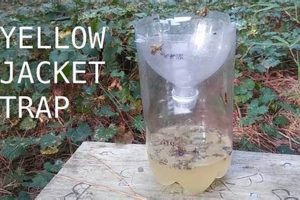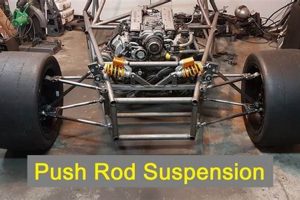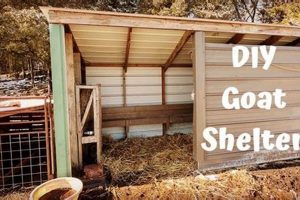The creation of a personal meat-curing and flavoring structure offers a unique avenue for culinary enthusiasts. Such an undertaking allows for the precise control of smoking conditions, leading to customized flavor profiles unattainable through commercial products. These structures can range from simple, repurposed containers to elaborate, purpose-built constructions.
Constructing such a unit presents several advantages. It promotes self-sufficiency, reduces reliance on mass-produced foods, and offers significant cost savings over time. The practice also revives traditional food preservation techniques, providing a tangible connection to culinary heritage and a deeper understanding of food science.
The subsequent discussion will explore various design considerations, construction methods, and operational guidelines crucial for successful creation and use. Material selection, temperature regulation, and safety protocols will be examined in detail to ensure a safe and effective smoking experience.
Essential Considerations for Smokehouse Construction
Successful smokehouse construction requires careful planning and execution. Adherence to fundamental principles ensures a safe and effective smoking environment.
Tip 1: Material Selection: Prioritize non-toxic materials. Avoid treated lumber, galvanized steel, or plastics that may release harmful chemicals when heated. Untreated wood, brick, or stainless steel are preferable options.
Tip 2: Smoke Containment: Ensure adequate sealing to retain smoke and heat. Gaps and cracks compromise temperature control and reduce efficiency. Use high-temperature sealant to minimize leaks.
Tip 3: Ventilation Control: Implement adjustable vents for managing airflow and smoke density. Precise ventilation is crucial for achieving desired flavor profiles and preventing creosote buildup.
Tip 4: Temperature Monitoring: Integrate reliable thermometers to monitor internal temperatures. Accurate temperature readings are essential for safe and effective smoking, particularly for meat products.
Tip 5: Fire Safety: Maintain a safe distance between the heat source and combustible materials. Use a spark arrestor to prevent embers from escaping and potentially causing a fire.
Tip 6: Structural Stability: Ensure the structure is stable and capable of withstanding environmental conditions. Proper bracing and a solid foundation are critical for long-term durability.
Tip 7: Cleaning and Maintenance: Design the structure for easy cleaning and maintenance. Regular cleaning prevents the accumulation of grease and creosote, reducing fire hazards and ensuring food safety.
Following these guidelines contributes significantly to the construction of a reliable and safe smokehouse, enabling consistent and flavorful results.
The subsequent section will delve into specific design examples and construction techniques for various types of smokers.
1. Design Feasibility
Design feasibility, in the context of constructing a smokehouse, constitutes a critical preliminary assessment. It determines the practicality and viability of translating a conceptual design into a tangible, functional structure.
- Spatial Constraints and Site Suitability
The available physical space dictates the maximum size and configuration of the structure. A limited footprint may necessitate a vertical design, while ample space allows for a horizontal layout. Site suitability encompasses factors like ground stability, wind exposure, and proximity to combustible materials. Design must address these conditions.
- Budgetary Limitations and Resource Availability
Financial resources significantly influence material choices and construction complexity. A limited budget may necessitate the use of reclaimed or low-cost materials, while a more substantial budget permits the use of premium materials and advanced features. Resource availability, including access to tools and skilled labor, also shapes design decisions.
- Skill Level and Construction Expertise
The constructor’s skill level directly impacts the complexity and sophistication of the design. A novice builder may opt for a simple, straightforward design, while an experienced builder can undertake more intricate and ambitious projects. Design should align with the constructor’s capabilities to ensure successful implementation.
- Regulatory Compliance and Safety Considerations
Local building codes and regulations may impose specific requirements regarding materials, dimensions, and safety features. Design must adhere to these regulations to ensure legal compliance and prevent potential hazards. Safety considerations, such as fire resistance and ventilation, are paramount and must be integrated into the design.
These facets of design feasibility are interrelated and collectively determine the practicality of a smokehouse project. A thorough assessment of these factors prior to construction minimizes potential challenges and maximizes the likelihood of a successful outcome.
2. Material Sourcing
Material sourcing for smokehouse construction exerts a profound influence on the unit’s performance, longevity, and, crucially, safety. The materials employed directly impact temperature regulation, smoke containment, and the potential for contamination of the smoked product. Inadequate material selection can compromise the integrity of the entire process.
Consider the selection of wood for the structure itself. Pressure-treated lumber, for instance, contains chemical preservatives that, when heated, can leach into the food being smoked, rendering it unsafe for consumption. Conversely, untreated hardwoods, such as oak or hickory, offer structural stability and do not introduce harmful substances. Similarly, the choice of metal components requires careful consideration. Galvanized steel, when exposed to high temperatures, releases zinc fumes, posing a health hazard. Stainless steel represents a safer alternative, offering durability and resistance to corrosion without the risk of contamination. A practical example is the selection of appropriate insulation material. Fiberglass insulation, while effective at retaining heat, may release microscopic fibers that contaminate the smoked food. Safer options include mineral wool or high-temperature silicone sealants.
Effective material sourcing demands a thorough understanding of material properties and their potential impact on the smoking process. Prioritizing food-grade materials and avoiding potentially hazardous substances is paramount. Proper material sourcing contributes significantly to the creation of a safe, effective, and durable smokehouse, ultimately ensuring the quality and safety of the smoked product. Neglecting this critical aspect can lead to compromised food s
afety and structural instability.
3. Temperature Control
Temperature control is an indispensable facet of smokehouse operation. Precise regulation ensures both food safety and the development of desired flavor profiles. Variations can lead to undercooked or overcooked products, impacting palatability and safety.
- Heat Source Modulation
The heat source, whether electric, gas, or wood-fired, requires meticulous management. Electric smokers often employ thermostats, providing consistent temperature. Gas smokers utilize adjustable valves for flame regulation. Wood-fired units necessitate careful monitoring and adjustment of the fuel source to maintain the target temperature. Failure to accurately modulate the heat source results in temperature fluctuations detrimental to the smoking process.
- Ventilation Management
Ventilation controls airflow, impacting combustion rate and heat retention. Intake vents regulate oxygen supply to the heat source, influencing its intensity. Exhaust vents allow for the release of smoke and moisture, affecting the internal temperature and humidity. Adjusting vent settings based on environmental conditions and the desired smoking profile is crucial. Insufficient ventilation causes creosote buildup; excessive ventilation compromises heat retention.
- Insulation Effectiveness
Insulation minimizes heat loss, improving temperature stability and fuel efficiency. Well-insulated smokehouses maintain consistent internal temperatures even under fluctuating ambient conditions. Insulation materials such as fiberglass, mineral wool, or ceramic blankets reduce heat transfer through the walls and door of the structure. Proper insulation contributes to uniform cooking and reduces energy consumption.
- Thermometric Monitoring
Reliable thermometric devices are essential for accurate temperature assessment. Internal thermometers measure the temperature of the smokehouse environment, while probe thermometers monitor the internal temperature of the food being smoked. Regular temperature checks allow for timely adjustments to the heat source or ventilation settings. Calibrated thermometers provide accurate readings, preventing undercooking or overcooking.
Effective temperature control is a function of these integrated elements. A well-designed smokehouse incorporates a responsive heat source, adjustable ventilation, effective insulation, and accurate temperature monitoring, enabling precise regulation of the smoking environment. The absence of even one element can compromise the entire process, resulting in inconsistent results.
4. Smoke Generation
Smoke generation constitutes a core process within the operation of a personal meat-curing and flavoring unit. The selection of fuel and method of combustion directly influences the flavor profile, preservation characteristics, and overall quality of the final product. Improper smoke generation can lead to undesirable flavors or potential health hazards.
- Fuel Selection
The choice of fuel significantly impacts the flavor and aroma imparted to the food. Hardwoods such as hickory, oak, and maple are commonly used for their distinct flavors. Fruitwoods like apple and cherry contribute sweeter, milder notes. Softwoods, such as pine, are generally avoided due to their resinous content, which can produce acrid and potentially harmful smoke. The moisture content of the wood also plays a crucial role. Dry wood burns hotter and produces less smoke, while slightly damp wood smolders more readily, generating a denser smoke. Experimentation with different wood types allows for customization of flavor profiles.
- Combustion Methods
Various combustion methods can be employed in personal curing structures. Direct heat smoking involves placing the food directly in the path of the smoke and heat source. Indirect heat smoking separates the food from the direct heat, relying on convection to cook the food. Cold smoking utilizes smoke at temperatures below 85F (29C) for flavoring and preservation without cooking. The choice of combustion method depends on the desired outcome and the type of food being processed. For example, sausage making typically employs cold smoking.
- Smoke Density Management
Controlling smoke density is essential for achieving the desired flavor and preventing over-smoking. Insufficient smoke results in a bland product, while excessive smoke can produce a bitter or acrid taste. Smoke density is regulated through ventilation and fuel management. Opening vents reduces smoke concentration, while adding more fuel increases it. Monitoring the color and intensity of the smoke provides feedback for adjusting these parameters. Thin, blue smoke generally indicates optimal combustion, while thick, white smoke may suggest incomplete combustion.
- Smoke Delivery Systems
Efficient smoke delivery systems ensure uniform smoke exposure to the food. Simple structures may rely on natural convection to distribute smoke, while more sophisticated designs incorporate fans or baffles to enhance circulation. Smoke generators, such as pellet smokers or wood chip trays, provide a consistent and controlled source of smoke. The design of the smoke delivery system influences the evenness of smoke penetration and the overall consistency of the smoking process.
These facets of smoke generation highlight the interconnectedness of fuel selection, combustion methods, smoke density management, and smoke delivery systems. Mastery of these elements facilitates the creation of consistently flavorful and well-preserved products. The personal curing structure becomes a canvas for culinary creativity when these principles are understood and applied.
5. Food Safety
Within the context of personal curing structures, food safety transcends mere suggestion; it forms an irrefutable prerequisite for responsible operation. The inherent nature of smoking, a process involving extended exposure to potentially favorable conditions for microbial growth, necessitates stringent adherence to established food safety protocols. Failure to implement these safeguards introduces significant risks, potentially leading to foodborne illnesses.
The significance of maintaining proper internal temperatures provides a salient example. Pathogens, such as Salmonella and E. coli, thrive within a specific temperature range. If the internal temperature of the food being smoked remains within this danger zone for an extended period, these pathogens can proliferate to unsafe levels. This underscores the critical need for accurate temperature monitoring and precise control over the smoking environment. Furthermore, proper handling and preparation of the raw materials prior to smoking are equally vital. Cross-contamination, where harmful bacteria transfer from raw to cooked foods, represents a significant hazard. Maintaining separate cutting boards and utensils for raw and cooked items, along with thorough handwashing, serves as an important preventive measure. The use of appropriate curing salts, such as sodium nitrite, al
so inhibits the growth of Clostridium botulinum, the bacterium responsible for botulism, a potentially fatal form of food poisoning.
In conclusion, the integration of stringent food safety measures into the construction and operation of any personal curing structure represents a non-negotiable aspect of responsible food preparation. Overlooking these protocols introduces unacceptable risks to consumer health. Adherence to established guidelines, including temperature control, proper handling techniques, and the use of appropriate curing agents, serves as a cornerstone of safe and enjoyable smoked food production. Prioritizing food safety ensures that the flavors developed are enjoyed without compromising health.
6. Structural Integrity
Structural integrity, in the context of constructing a personal meat-curing and flavoring structure, denotes the ability of the unit to withstand applied loads and environmental stressors without failure. This aspect is paramount not only for the longevity of the structure but also for operational safety. A structurally compromised unit poses a risk of collapse, potentially causing damage to property and physical harm.
- Foundation Stability
The foundation serves as the base upon which the entire structure rests. Its stability is critical for preventing settling, tilting, or collapse. Inadequate foundations, particularly on unstable ground, may lead to structural failures. The foundation’s composition (concrete slab, compacted gravel, etc.) must be appropriate for the soil conditions and the weight of the unit.
- Material Strength and Durability
The materials used in construction must possess sufficient strength to bear the weight of the structure and withstand environmental forces such as wind, snow, and temperature fluctuations. Untreated lumber, for instance, is susceptible to rot and insect damage, compromising its structural integrity over time. The selection of materials should consider both initial strength and long-term durability.
- Joint Integrity
Joints represent points of connection between structural elements. The strength and stability of these joints are crucial for distributing loads and preventing localized failures. Weak or improperly constructed joints can become points of stress concentration, leading to cracks, warping, or complete separation of components. Proper fasteners (screws, bolts, welds) and joint design are essential for ensuring joint integrity.
- Load Distribution and Support
The design of the structure must effectively distribute the weight of the unit and any additional loads (e.g., hanging meat) across the supporting members. Inadequate load distribution can lead to overloading of specific components, increasing the risk of failure. Reinforcements, bracing, and proper spacing of structural elements contribute to effective load distribution.
These facets of structural integrity are interconnected and collectively determine the overall stability and safety of a personally built smoking apparatus. Neglecting any aspect can compromise the entire structure. Adherence to sound engineering principles and best construction practices is essential for ensuring a structurally sound and reliable unit. Without structural integrity, the entire project may become unsafe and unsuitable for its intended purpose.
7. Operational Efficiency
Operational efficiency, in the context of constructing a personal meat-curing and flavoring apparatus, refers to the ratio of output (smoked product) to input (resources expended). Maximizing this ratio is paramount for both cost-effectiveness and resource conservation. Inefficiencies translate directly into increased operational costs and potentially compromised product quality.
- Fuel Consumption Optimization
The type and amount of fuel consumed significantly impact operational costs. Insulated designs reduce heat loss, minimizing fuel requirements and maintaining consistent internal temperatures. Implementing precise airflow control mechanisms, such as adjustable vents, further optimizes combustion efficiency. Incorrect fuel selection or improper combustion techniques lead to excessive fuel consumption and temperature fluctuations.
- Temperature Stability and Regulation
Maintaining a stable and consistent internal temperature is crucial for both food safety and uniform product quality. Temperature fluctuations necessitate constant monitoring and adjustments, increasing labor input and potentially compromising the smoking process. Well-insulated structures with responsive temperature control systems minimize temperature variability, enhancing operational efficiency.
- Workflow Streamlining
The layout and design of the workspace influence the ease and speed of operation. A well-organized workspace minimizes unnecessary movement and facilitates efficient loading, unloading, and monitoring of the apparatus. Inefficient workflows result in increased labor costs and potential delays in the smoking process.
- Maintenance and Cleaning Procedures
Regular maintenance and cleaning are essential for preventing equipment malfunctions and ensuring optimal performance. Neglecting maintenance results in increased downtime and potential repair costs. Implementing efficient cleaning procedures minimizes labor requirements and prevents the buildup of contaminants that can affect product quality.
The interplay of these facets determines the overall operational efficiency. Constructing a personal curing structure that prioritizes fuel optimization, temperature stability, workflow streamlining, and effective maintenance procedures translates into reduced operational costs, enhanced product quality, and a more sustainable smoking practice. Conversely, neglecting these considerations leads to increased resource consumption and potentially compromised results.
Frequently Asked Questions
The following section addresses common inquiries regarding the construction and operation of a personal curing apparatus. These answers aim to provide clarity and guidance for those undertaking such a project.
Question 1: What constitutes the most suitable location for a self-constructed curing unit?
Optimal placement necessitates consideration of prevailing wind direction, proximity to combustible materials, and local ordinances. A location downwind from inhabited structures minimizes smoke nuisance. Adequate clearance from flammable vegetation and buildings reduces fire risk. Verification of compliance with municipal regulations is essential.
Question 2: Which materials are deemed inappropriate for personal curing structure construction?
Treated lumber, galvanized steel, and plastics are unsuitable due to the potential for releasing harmful chemicals when heated. Pressure-treated wood contains preservatives that can contaminate food. Galvanized coatings emit toxic fumes at high temperatures. Plastics may melt or degrade, introducing undesirable substances into the smoking environment.
Question 3: What are the recommended practices for mitigating fire hazards associated with curing structures?
Implementation of a spark arrestor on the c
himney prevents the escape of embers. Maintaining a clear zone around the unit, free of combustible materials, reduces the risk of fire spread. A readily accessible fire extinguisher provides a means of suppressing accidental fires. Regular inspection and cleaning minimizes the accumulation of flammable creosote.
Question 4: How does one effectively regulate temperature within a curing structure?
Temperature management involves controlling airflow, adjusting the heat source, and utilizing insulation. Adjustable vents regulate oxygen supply to the fuel and exhaust smoke. Precise modulation of the heat source (e.g., adjusting gas valve or adding wood) maintains the target temperature. Insulation minimizes heat loss, improving temperature stability.
Question 5: What is the role of curing salts in preserving smoked meats?
Curing salts, specifically sodium nitrite and sodium nitrate, inhibit the growth of Clostridium botulinum, the bacterium responsible for botulism. These salts also contribute to the characteristic color and flavor of cured meats. Adherence to recommended concentrations is crucial to ensure both safety and palatability.
Question 6: How frequently should a personal curing structure undergo cleaning and maintenance?
Regular cleaning, ideally after each use, prevents the accumulation of grease and creosote, reducing fire hazards and maintaining hygiene. Inspection of structural components for signs of wear or damage should occur periodically. Prompt repairs address any identified issues, ensuring the continued safe and efficient operation of the unit.
In summary, the preceding responses highlight key considerations for constructing and operating a curing structure safely and effectively. Diligent attention to these principles promotes successful outcomes.
The following section provides guidance on selecting the optimal design for a personal curing structure based on individual needs and resources.
Conclusion
This exploration has detailed critical facets of constructing and operating a personalized smokehouse. Considerations ranging from material selection and structural integrity to temperature control and food safety dictate the success and safety of such an endeavor. A thorough understanding of these principles is paramount.
The pursuit of a DIY smokehouse presents opportunities for culinary innovation and self-sufficiency. While requiring diligence and adherence to safety protocols, the rewards of crafting personalized, flavorful, and preserved foods justify the effort. Further exploration of advanced techniques and innovative designs will undoubtedly shape the future of this craft.







